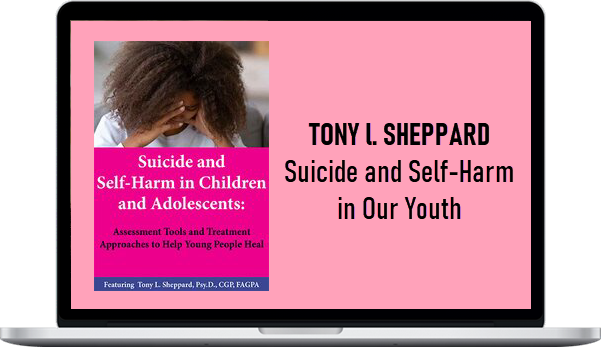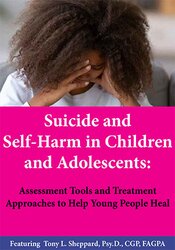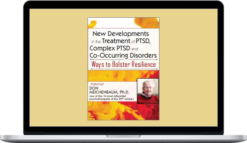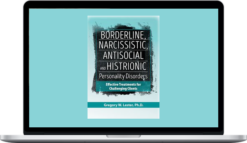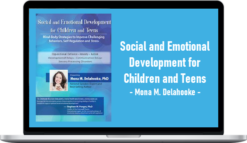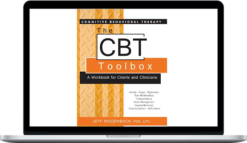Tony L. Sheppard – Suicide and Self-Harm in Our Youth
$58.00 $13.00
»Instant Delivery
Description
Tony L. Sheppard – Suicide and Self-Harm in Our Youth
- Non-Suicidal Self Injury (NSSI) and Suicide
- Primary motivations and neuropsychology
- NSSI and trauma
- Suicide and Suicidal Ideation – symptom or disease
- Is youth suicide contagious?
- Means and means restriction
- Relationship between NSSI and suicide
- Assessment is the Key to Effective Treatment
- A matter of trust – clinical implications of research on confidentiality of minors with mental health concerns
- Differential diagnosis
- Clinical screening and formal assessment tools for NSSI
- Recency and frequency
- Severity
- Triggers
Who’s aware
- Suicide risk assessment
- SAFE-T
- PATH WARM
- Ideation, plan, means, intent
- Level of risk
- Intervention
- Use the Stages of Change/Motivational Interviewing Model in Treatment
- Assess readiness
- Gauge interventions
- Motivational techniques that engage teens and adolescents in their treatment
- Sustain and maintain recovery
Case example
- Therapeutic Interventions Drawn from Interpersonal Neurobiology, CBT, and DBT
- Develop distraction strategies
- Build coping skills
- Enhance self-esteem and self-acceptance
- Improve relationships and relational skills
- Address trauma (Big T and Little T)
- Develop problem solving skills
- The role of adjunctive therapies
- Replacement Behaviors for NSSI
- Use of alternative harm behaviors
- Simulation strategies
Case example
- Employ a Multi-Systemic Treatment Approach
- Working with parents
- Educate and consult
- No one understands me – Validation in the family context
- The issue of control
- Contract to curb NSSI and Suicidal Ideation Monitoring
- The role of the school
- Who needs to know/how much?
- Reporting to parents
- Build “Trusted Adult” support networks
- The role of peers
- The impact of Veteran suicide on family dynamics and connectedness
- Social Media, NSSI, and Suicide: The Harm and The Help
- Cyberbullicide – The impact of online bullying
- Video sharing, social media and self-injury
- Support and connection through social media, apps, and other technologies
- 5 tips for assessing online resources
- Online tools you can use
Please Note: PESI is not affiliated or associated with Marsha M. Linehan, PhD, ABPP, or her organizations.
Would you like to receive Tony L. Sheppard – Suicide and Self-Harm in Our Youth ?
Description:
- Recognize indirect signs of suicide risk and effectively measure an array of risk factors
- Motivate and positively engage suicidal and self-harming youth in their treatment
- Interventions to build your clients’ coping skills and improve their interpersonal effectiveness
- Effectively work with school, peers and family – employ a multi-systemic treatment approach
- Unlock online tools that facilitate social connection and develop a sense of belonging in your clients
- Young people are dying. Alone and afraid.
Hanging, overdoses, slashed wrists. Young, horrific, unnecessary deaths. The human toll is staggering. The suffering devastating. Promising futures erased. Heart-broken parents aching to hold their children one last time.
Desperate adolescents feeling isolated and unloved in their inner lives often wear a mask of strength. Terrified of hospitalization and stigma if they share their true feelings, they face a lonely and frightening battle.
You are the one working with them. The one trying to prevent this. The one who’s supposed to help this kid get better. Is there something I’m missing? Could I be doing more? How do I manage my liability?
You feel the weight of keeping someone alive. Being the one expected to prevent a suicide can be a heavy burden. There’s nowhere to hide from the responsibility and fear – or the guilt that could come if something happens.
- But fear won’t steer you away. You won’t let them face it alone.
- Be prepared to offer these kids guidance and hope.
- Dr. Tony Sheppard is a licensed psychologist and certified group psychotherapist who has trained hundreds of clinicians, educators, and medical professionals in the treatment of self-harm and suicidal ideation.
- In more than 15 years of working with children, adolescents, and young adults, Tony has uncovered the specific tools and techniques you need to help your young suicidal and self-harming clients.
- Watch this essential seminar and walk away with:
- Assessment and screening tools specifically tailored for NSSI and suicidal youth.
- Tips for working with schools, peers, and families to improve treatment outcomes.
- Motivational techniques that engage teens and adolescents in their treatment.
- Replacement behaviors for Non-Suicidal Self Injury clients.
- Distraction strategies that help clients cope in crisis.
- Interventions that enhance self-esteem and self-acceptance.
- Exercises that develop problem solving skills in clients and their families.
- 5 tips for assessing online resources for helping suicidal and self-harming youth.
Join Tony as he weaves his expertise and compassion into the practical skills you need to guide these kids out of the darkness back into the light!
More courses from the same author: Tony L. Sheppard
Delivery Policy
When will I receive my course?
You will receive a link to download your course immediately or within 1 to 21 days. It depends on the product you buy, so please read the short description of the product carefully before making a purchase.
How is my course delivered?
We share courses through Google Drive, so once your order is complete, you'll receive an invitation to view the course in your email.
To avoid any delay in delivery, please provide a Google mail and enter your email address correctly in the Checkout Page.
In case you submit a wrong email address, please contact us to resend the course to the correct email.
How do I check status of my order?
Please log in to HealingCourse account then go to Order Page. You will find all your orders includes number, date, status and total price.
If the status is Processing: Your course is being uploaded. Please be patient and wait for us to complete your order. If your order has multiple courses and one of them has not been updated with the download link, the status of the order is also Processing.
If the status is Completed: Your course is ready for immediate download. Click "VIEW" to view details and download the course.
Where can I find my course?
Once your order is complete, a link to download the course will automatically be sent to your email.
You can also get the download link by logging into your HealingCourse account then going to Downloads Page.
Related products
Total sold: 2
Total sold: 8
Total sold: 1
Total sold: 1


